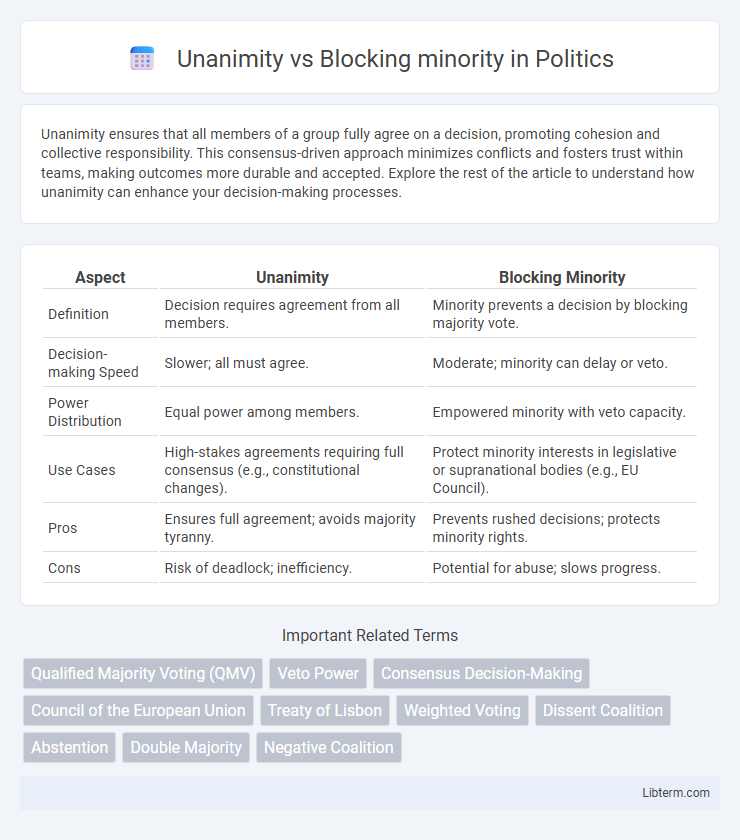Unanimity ensures that all members of a group fully agree on a decision, promoting cohesion and collective responsibility. This consensus-driven approach minimizes conflicts and fosters trust within teams, making outcomes more durable and accepted. Explore the rest of the article to understand how unanimity can enhance your decision-making processes.
Table of Comparison
| Aspect | Unanimity | Blocking Minority |
|---|---|---|
| Definition | Decision requires agreement from all members. | Minority prevents a decision by blocking majority vote. |
| Decision-making Speed | Slower; all must agree. | Moderate; minority can delay or veto. |
| Power Distribution | Equal power among members. | Empowered minority with veto capacity. |
| Use Cases | High-stakes agreements requiring full consensus (e.g., constitutional changes). | Protect minority interests in legislative or supranational bodies (e.g., EU Council). |
| Pros | Ensures full agreement; avoids majority tyranny. | Prevents rushed decisions; protects minority rights. |
| Cons | Risk of deadlock; inefficiency. | Potential for abuse; slows progress. |
Understanding Unanimity: Definition and Context
Unanimity refers to a decision-making process where all members of a group agree on a proposal, ensuring collective consent and avoiding dissent. In political or organizational contexts, unanimity often signifies total agreement, which can enhance legitimacy and solidify group cohesion. Understanding unanimity is crucial for grasping how blocking minorities operate, as a single member's dissent can prevent consensus and alter decision outcomes.
What is a Blocking Minority?
A blocking minority is a group within a decision-making body that possesses enough voting power to prevent the adoption of a proposal, even if the majority supports it. This mechanism ensures that critical decisions require not only a majority but also no significant opposition, protecting minority interests in legislative or corporate contexts. In contrast to unanimity, where all members must agree, a blocking minority specifically enables a subset to veto proposals and maintain checks and balances.
Historical Origins of Unanimity and Blocking Minority
The historical origins of unanimity trace back to ancient democratic practices such as Athenian assemblies, where collective decision-making required full agreement to ensure social cohesion and legitimacy. The concept of blocking minority emerged in modern political institutions like the European Union, designed to protect the interests of smaller member states by allowing a minority to veto proposals, preventing dominance by larger states. These mechanisms reflect evolving approaches to balance majority rule with minority rights in governance systems.
How Unanimity Works in Decision-Making
Unanimity in decision-making requires all members of a group to agree on a proposal, ensuring full consensus before any action is taken. This process prevents any single member from being overridden, promoting equal influence and cooperation among participants. It contrasts with blocking minority systems, where only a subset can veto decisions, potentially allowing broader agreement without total unanimity.
Mechanisms Behind Blocking Minority
The mechanisms behind a blocking minority in decision-making bodies involve a specified minimum number of members or voting weight necessary to prevent the adoption of proposals, often designed to protect minority interests from majority dominance. This veto power operates in institutions like the European Union Council, where blocking minority rules require at least four member states representing a combined population threshold to obstruct a decision. This system balances influence by enabling a subset of members to halt legislation, ensuring broader consensus beyond a mere majority or unanimity.
Advantages of Unanimity in Group Decisions
Unanimity in group decisions ensures complete agreement, fostering a strong sense of commitment and unity among members. This decision-making process enhances mutual trust, reduces conflicts, and promotes collective responsibility for outcomes. It often leads to more thorough discussions and higher-quality decisions, as all perspectives must be considered and reconciled.
Risks and Challenges of the Blocking Minority Rule
The blocking minority rule poses significant risks by allowing a small coalition of states or shareholders to halt decisions, creating potential deadlock and impeding effective governance. This challenge undermines majority rule principles, leading to prolonged negotiations, reduced decision-making efficiency, and increased vulnerability to strategic bloc formations aimed at paralyzing progress. The risk of exploitation by a minority necessitates robust mechanisms to balance inclusivity with operational functionality in corporate or political decision frameworks.
Real-world Examples: Unanimity vs Blocking Minority
In international organizations like the European Union, unanimity requires all member states to agree before a decision passes, ensuring complete consensus but often slowing the process. Conversely, a blocking minority allows a small coalition of countries to prevent a decision, exemplified by the EU's qualified majority voting system where at least four countries representing 35% of the population can block measures. Real-world examples include the EU budget negotiations, where unanimity caused delays, whereas blocking minorities enabled key members to influence policies without full consensus.
Impact on Policy-Making and Negotiations
Unanimity ensures full agreement among all parties, leading to decisions with strong legitimacy but often results in slower policy-making due to the risk of a single veto. Blocking minority allows a subset of stakeholders to prevent agreement, which can protect minority interests but may also lead to negotiation deadlocks and diluted policy outcomes. The balance between unanimity and blocking minority rules critically influences the efficiency and inclusiveness of decision-making processes in international organizations and corporate boards.
Choosing Between Unanimity and Blocking Minority: Key Considerations
Choosing between unanimity and blocking minority voting rules hinges on balancing decision efficiency with protection of minority interests. Unanimity ensures full consensus, preventing any party from being overruled, but may lead to deadlocks and slow progress. Blocking minority allows significant minority groups to veto decisions, fostering compromise while enabling the majority to act when consensus is unreachable.
Unanimity Infographic

 libterm.com
libterm.com